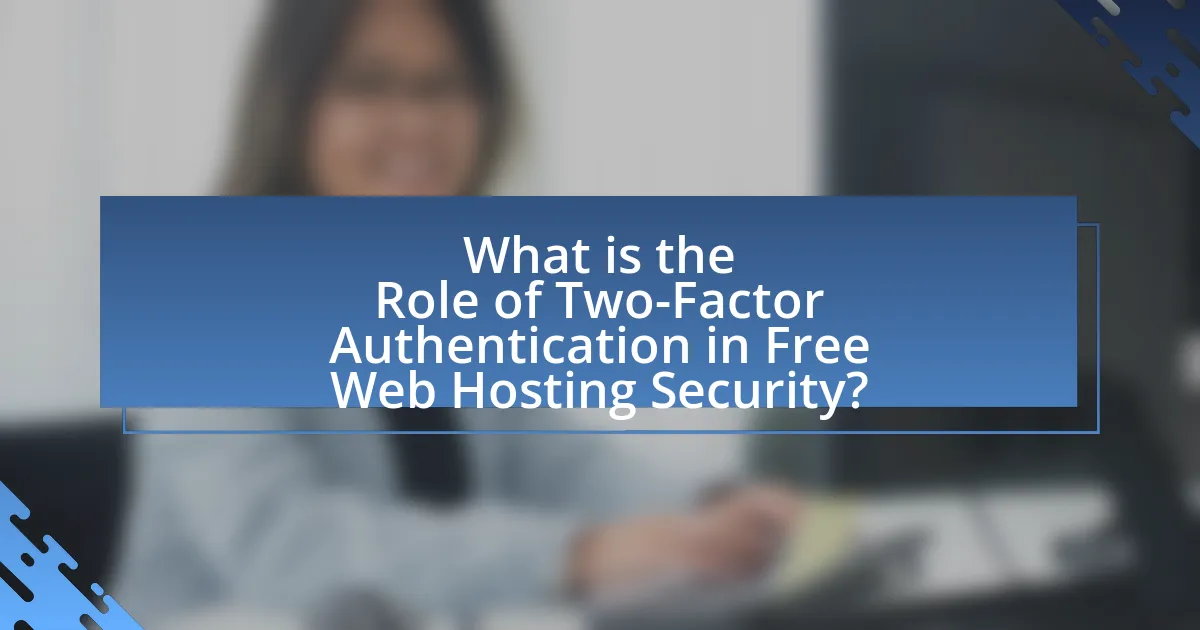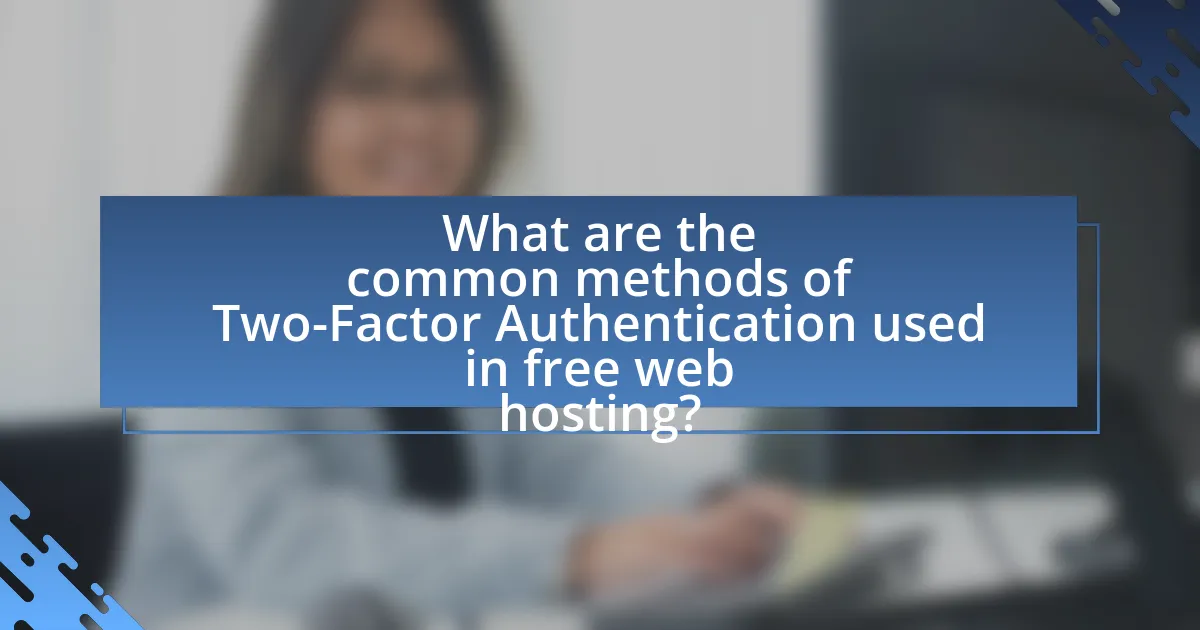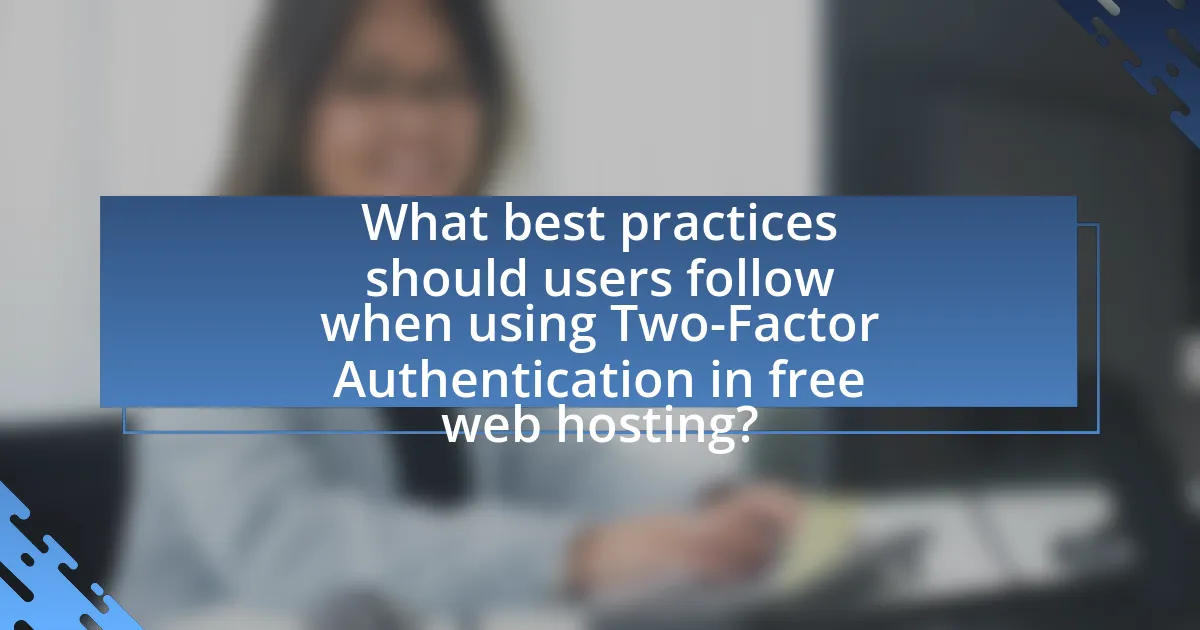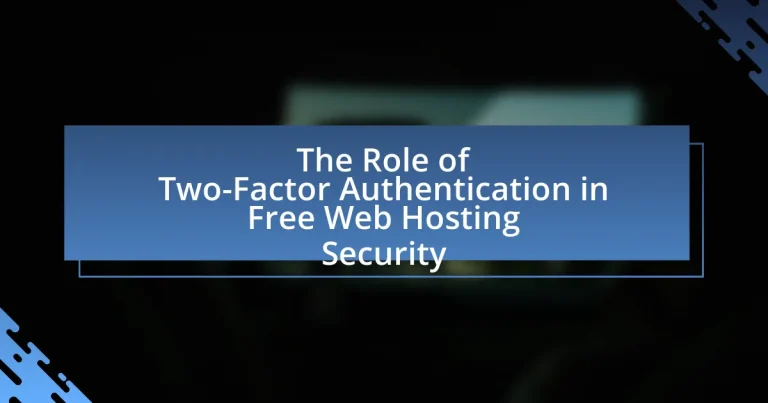Two-Factor Authentication (2FA) plays a crucial role in enhancing security for users of free web hosting services by requiring two forms of verification before account access. This article examines how 2FA mitigates risks associated with unauthorized access and data breaches, particularly in environments that often lack robust security measures. It discusses the key components of 2FA, common methods used in free web hosting, and the variations in implementation among different providers. Additionally, the article highlights best practices for users to effectively set up and maintain 2FA, ensuring their accounts remain secure against potential threats.

What is the Role of Two-Factor Authentication in Free Web Hosting Security?
Two-Factor Authentication (2FA) significantly enhances security in free web hosting by requiring users to provide two forms of verification before accessing their accounts. This additional layer of security mitigates the risk of unauthorized access, which is particularly crucial in free web hosting environments that may lack robust security measures. According to a study by Google, implementing 2FA can block 99.9% of automated attacks, demonstrating its effectiveness in protecting user accounts from breaches. By combining something the user knows (like a password) with something the user has (like a mobile device for a verification code), 2FA ensures that even if a password is compromised, unauthorized users cannot easily gain access to the account.
How does Two-Factor Authentication enhance security in free web hosting?
Two-Factor Authentication (2FA) enhances security in free web hosting by requiring users to provide two forms of verification before accessing their accounts. This additional layer of security significantly reduces the risk of unauthorized access, as even if a user’s password is compromised, an attacker would still need the second factor, typically a code sent to a mobile device or generated by an authentication app, to gain entry. According to a study by Google, implementing 2FA can block 99.9% of automated attacks, demonstrating its effectiveness in safeguarding accounts against common threats such as phishing and credential stuffing.
What are the key components of Two-Factor Authentication?
The key components of Two-Factor Authentication (2FA) are something you possess and something you know. The first component, something you possess, typically refers to a physical device such as a smartphone or a hardware token that generates a time-sensitive code. The second component, something you know, usually involves a password or PIN that the user must enter. This dual-layer security approach significantly enhances account protection by requiring both elements for access, thereby reducing the likelihood of unauthorized access. According to a study by Google, implementing 2FA can block 99.9% of automated attacks, demonstrating its effectiveness in securing user accounts.
How does the implementation of Two-Factor Authentication differ in free web hosting?
The implementation of Two-Factor Authentication (2FA) in free web hosting typically lacks the robust features found in paid services. Free web hosting providers often offer limited security options, which may include basic 2FA methods like SMS or email verification, but they may not support more secure options such as authenticator apps or hardware tokens. This limitation arises because free services prioritize cost-cutting and may not invest in advanced security infrastructure. Consequently, users of free web hosting may face increased vulnerability to account breaches, as the less secure 2FA methods are easier to bypass compared to more sophisticated alternatives available in premium hosting plans.
Why is Two-Factor Authentication important for free web hosting users?
Two-Factor Authentication (2FA) is important for free web hosting users because it significantly enhances account security by requiring two forms of verification before granting access. Free web hosting services often attract a wide range of users, making them prime targets for cyberattacks. According to a report by Verizon, 81% of data breaches are due to compromised passwords, highlighting the vulnerability of accounts that rely solely on single-factor authentication. By implementing 2FA, users add an additional layer of protection, which can deter unauthorized access even if passwords are stolen or guessed. This is particularly crucial for free web hosting users, who may not have access to advanced security features typically available in paid services.
What risks do free web hosting users face without Two-Factor Authentication?
Free web hosting users face significant risks without Two-Factor Authentication (2FA), primarily including unauthorized access to their accounts and data breaches. Without 2FA, a single compromised password can lead to complete account takeover, as attackers can easily exploit weak security measures typical of free hosting services. According to a 2020 report by Verizon, 81% of data breaches are linked to stolen or weak passwords, highlighting the vulnerability of accounts lacking additional security layers like 2FA. Furthermore, free web hosting platforms often lack robust security protocols, making them prime targets for cybercriminals. Thus, the absence of 2FA increases the likelihood of account hijacking, data loss, and potential exploitation of sensitive information.
How does Two-Factor Authentication mitigate these risks?
Two-Factor Authentication (2FA) mitigates security risks by requiring two forms of verification before granting access to an account. This additional layer of security significantly reduces the likelihood of unauthorized access, as attackers would need both the user’s password and a second factor, such as a code sent to a mobile device. According to a study by Google, implementing 2FA can block 100% of automated bots and 96% of phishing attacks, demonstrating its effectiveness in enhancing account security.

What are the common methods of Two-Factor Authentication used in free web hosting?
Common methods of Two-Factor Authentication (2FA) used in free web hosting include SMS-based verification, email-based verification, and authenticator apps. SMS-based verification sends a one-time code to the user’s mobile phone, which must be entered to access the account. Email-based verification sends a similar code to the user’s registered email address. Authenticator apps, such as Google Authenticator or Authy, generate time-based one-time passwords (TOTPs) that users input alongside their passwords. These methods enhance security by requiring a second form of verification, making unauthorized access significantly more difficult.
What types of authentication factors are typically used?
Authentication factors are typically categorized into three types: something you know, something you have, and something you are. “Something you know” includes passwords and PINs, which require the user to recall specific information. “Something you have” refers to physical items like security tokens, smart cards, or mobile devices that generate one-time codes. “Something you are” encompasses biometric data, such as fingerprints, facial recognition, or iris scans, which rely on unique physical characteristics of the user. These categories are foundational in establishing secure authentication processes, as they enhance security by requiring multiple forms of verification.
How do SMS and email verification work as authentication factors?
SMS and email verification serve as authentication factors by requiring users to provide a one-time code sent to their mobile device or email address during the login process. This method enhances security by ensuring that even if a password is compromised, unauthorized access is prevented unless the attacker also has access to the user’s phone or email.
In SMS verification, a unique code is generated and sent via text message to the registered phone number, which the user must enter to complete the authentication. Email verification operates similarly, where a code or link is sent to the user’s email, requiring them to confirm their identity.
This dual-layer approach significantly reduces the risk of unauthorized access, as studies indicate that two-factor authentication can block up to 99.9% of automated attacks, according to the 2019 Verizon Data Breach Investigations Report.
What are the advantages and disadvantages of using mobile authentication apps?
Mobile authentication apps provide enhanced security through two-factor authentication, significantly reducing the risk of unauthorized access. They generate time-sensitive codes that are difficult for attackers to intercept, thus improving overall account protection. However, disadvantages include potential reliance on mobile devices, which can be lost or damaged, leading to access issues. Additionally, users may face challenges with usability and setup, particularly if they are not tech-savvy. These factors can hinder the effectiveness of mobile authentication apps in certain user demographics.
How do different free web hosting providers implement Two-Factor Authentication?
Different free web hosting providers implement Two-Factor Authentication (2FA) through various methods, primarily using SMS-based verification, authenticator apps, or email-based codes. For instance, InfinityFree and 000webhost offer SMS verification as a primary method, where users receive a text message with a code to enter during the login process. In contrast, providers like AwardSpace and Freehostia utilize authenticator apps, allowing users to generate time-based one-time passwords (TOTPs) for enhanced security. Additionally, some platforms, such as FreeWebHostingArea, send verification codes via email, which users must input to complete the login. These implementations enhance security by requiring a second form of verification beyond just a password, significantly reducing the risk of unauthorized access.
What are the variations in Two-Factor Authentication features among popular free web hosting services?
Two-Factor Authentication (2FA) features vary significantly among popular free web hosting services. For instance, InfinityFree offers 2FA through email verification, while 000webhost provides an option for SMS-based authentication. In contrast, Freehostia supports 2FA via Google Authenticator, enhancing security with time-based one-time passwords. Additionally, AwardSpace does not offer 2FA, which may expose users to higher security risks. These differences highlight the importance of evaluating 2FA options when selecting a free web hosting service, as robust authentication methods can significantly improve account security.
How can users choose a free web hosting provider based on their Two-Factor Authentication offerings?
Users can choose a free web hosting provider by evaluating the availability and effectiveness of their Two-Factor Authentication (2FA) offerings. A provider that supports 2FA enhances security by requiring a second form of verification, such as a text message or authentication app, in addition to a password. Users should look for providers that offer multiple 2FA options, as this flexibility allows for better security tailored to individual preferences. Additionally, checking user reviews and security audits can provide insights into the reliability of the 2FA implementation. Providers that have a strong reputation for security and transparent policies regarding 2FA are generally more trustworthy.

What best practices should users follow when using Two-Factor Authentication in free web hosting?
Users should enable Two-Factor Authentication (2FA) to enhance security in free web hosting environments. This practice significantly reduces the risk of unauthorized access by requiring a second form of verification, such as a code sent to a mobile device, in addition to the standard password. Users should also choose authentication methods that are less susceptible to interception, such as authenticator apps instead of SMS, as SMS can be vulnerable to SIM swapping attacks. Regularly updating recovery options and ensuring that backup codes are stored securely further strengthens account protection. Additionally, users should be cautious of phishing attempts that may target their 2FA codes, reinforcing the need for vigilance in recognizing suspicious communications.
How can users effectively set up Two-Factor Authentication?
Users can effectively set up Two-Factor Authentication (2FA) by following a series of straightforward steps. First, they should access the security settings of their online account, where they will typically find an option to enable 2FA. Next, users can choose their preferred method of receiving the second factor, which may include SMS codes, authentication apps like Google Authenticator, or hardware tokens. After selecting a method, users must follow the prompts to link their chosen method to their account, often requiring them to enter a verification code sent to their device. Finally, users should test the setup by logging out and attempting to log back in, ensuring that the 2FA process works correctly. This method is validated by security experts who emphasize that enabling 2FA significantly reduces the risk of unauthorized access, as it requires both something the user knows (password) and something the user has (the second factor).
What steps should users take to ensure their Two-Factor Authentication is secure?
To ensure Two-Factor Authentication (2FA) is secure, users should enable 2FA on all accounts that offer it, preferably using an authenticator app instead of SMS. Authenticator apps, such as Google Authenticator or Authy, generate time-based one-time passwords that are less susceptible to interception compared to SMS codes, which can be compromised through SIM swapping. Additionally, users should regularly update their passwords and ensure they are unique for each account, as this reduces the risk of unauthorized access. Implementing backup codes provided during the 2FA setup is also crucial, as they allow account recovery if the primary method is unavailable. Finally, users should be cautious of phishing attempts that may target their 2FA codes, ensuring they only enter codes on legitimate websites.
What common mistakes should users avoid when using Two-Factor Authentication?
Common mistakes users should avoid when using Two-Factor Authentication (2FA) include using easily guessable backup codes, failing to update their authentication methods after a device change, and neglecting to enable 2FA on all accounts that offer it. Using easily guessable backup codes can lead to unauthorized access, as attackers may exploit this weakness. Failing to update authentication methods can result in being locked out of accounts if the user loses access to their primary device. Neglecting to enable 2FA on all accounts leaves some accounts vulnerable, as attackers can target those without additional security measures. These mistakes can significantly undermine the effectiveness of 2FA in enhancing security.
What troubleshooting tips can help users with Two-Factor Authentication issues?
To resolve Two-Factor Authentication (2FA) issues, users should first verify that their device’s time settings are accurate, as discrepancies can prevent authentication codes from being accepted. Additionally, users should ensure that they are using the correct authentication method, whether it be an app, SMS, or email, and check for any connectivity issues that may hinder code delivery. If users are still experiencing problems, they should consider resetting their 2FA settings through their account security options or contacting customer support for assistance. These steps are essential as they address common pitfalls that can lead to authentication failures, ensuring users can regain access to their accounts securely.
How can users recover access if they lose their authentication device?
Users can recover access if they lose their authentication device by utilizing backup recovery options provided during the initial setup of two-factor authentication. These options often include recovery codes, which are unique codes generated at the time of enabling two-factor authentication, or by using an alternative method such as email or SMS verification. According to security best practices, users are advised to securely store these recovery codes in a safe location, as they serve as a fallback to regain access to their accounts.
What should users do if they encounter problems during the Two-Factor Authentication process?
Users encountering problems during the Two-Factor Authentication process should first verify that they are entering the correct authentication code and that their device is connected to the internet. If issues persist, users should check for any updates to their authentication app or consider restarting the app or device. Additionally, users can consult the service provider’s support documentation or contact customer support for further assistance. These steps are essential as they address common issues that can disrupt the authentication process, ensuring users can regain access to their accounts securely.


